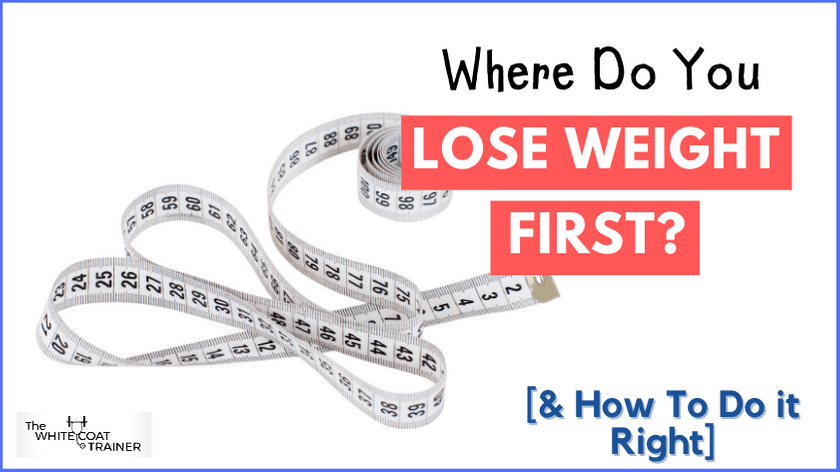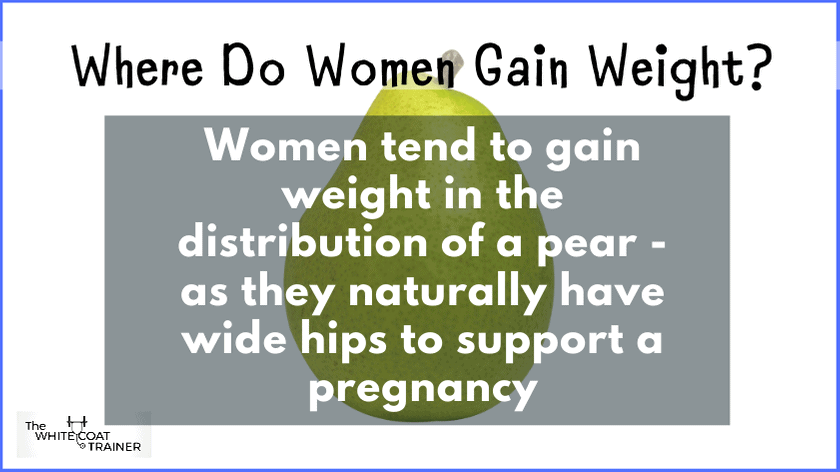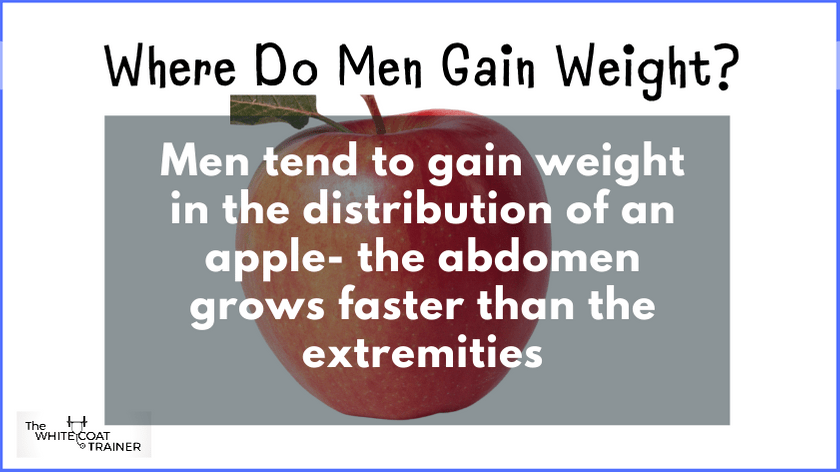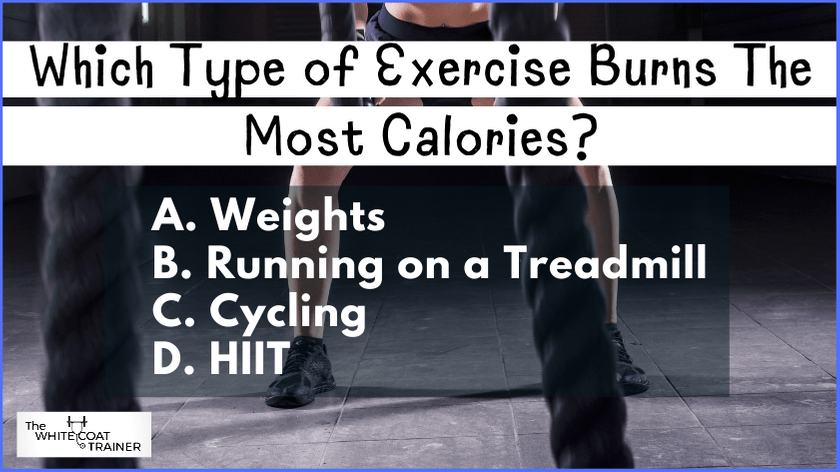Did you start making changes to your diet and want to know where you lose weight first?
Then you’re in the right place.
After reading this post, you’ll learn:
- Where you tend to lose weight from first,
- Where does fat go when you lose it,
- How long itll take to notice weight loss,
- Strategies to achieve a healthy weight,
- And lots more…
Let’s dive right in.

Where Do You Lose Weight First?
Many people think that you lose weight in your face first.
The first place that you lose fat from is completely different for everyone and is largely determined by your genetics.
The face just happens to be a place where weight loss is very noticeable.
So if not the face, where do you lose weight from first?
There are two general trends.
- The first trend is that you will lose weight where you normally gain it the fastest.
- For some people, weight usually goes right to their midsection. For others, its their hips and their legs.
- The other trend is that you might lose weight wherever you recently gained it.
- This tends to go hand in hand with where you normally gain weight the fastest.
There is, however a difference in how men and women lose weight.
Where Do Women Lose Weight First?
In general, men and women have different body shapes.
For one, women have breasts, which are largely composed of fatty tissue. This is a common location for weight gain to occur, and also a common location for women to lose weight first.
The waist is another common problem area for women.
Secondly, women, in general, have wider hips than men. This is why women are said to have a pear body shape: thin on the top, and wider at the hips and the legs.

The reason for this is obvious.
Women need to have hips that can carry a pregnancy.
The hips and thighs naturally carry a high number of fat cells relative to other parts of the female body.
More on that later.
Because of this, the thighs/ hips is usually the last place where a woman will lose fat.
Where Do Men Lose Weight First?
In contrast, men tend to carry more fat in the abdominal area. Hence, men have been called apples.
Despite this being a common location for weight gain, men have a tendency to lose weight in the legs first, followed by the arms and back.
This is generally the opposite of what most men desire. It is appealing to have muscular arms and toned legs to go along with a flat stomach.
Only after losing weight in the extremities, do men start losing weight in the midsection.

With that said, it is important to understand that these are general trends.
You may be radically different than this because of one little thing you may have heard of.
Why You Dont Have As Much Control Over Weight Loss As You Might Think
No matter how hard you diet, or how hard you exercise- the way you lose fat is already predetermined.
Your genetics always has, and always will trump everything.
This is why people who are the same height and the same weight can look so radically different.
There are also discrepancies depending on the body type you have.
Some people just carry more fat cells than others.
Some people have more thigh fat than others. Some have more in their upper body.
You can thank your parents for your fat distribution. Studies have shown that genetic factors can account for about 60% of your fat distribution. [1,2]
Studies have even identified genes responsible for fat accumulation. One gene that is leading the charge was actually called the Fatso gene. (It has since been renamed to the FTO gene). [3,4]
So what does this all mean?
It means that your body is unique and you may not have any control over how your body will look when you lose weight.
But I Heard That You Can Spot Train Or Spot Reduce Fat? (AKA Target Fat Loss)
You cannot spot reduce fat from a specific part of your body. No amount of toning exercises will tone any area in your body.
This is especially true in the abdomen. You cannot do one thousand repetitions of sit-ups and expect your belly fat to slim down. [5]
- By the way, you shouldn’t be doing sit-ups anyway. Get yourself an ab wheel instead.
This is counter-intuitive.
It makes perfect sense that your body would burn more fat from the body parts that you are constantly training. But there are plenty of studies to show that this is wrong.
A 2013 study in the journal of strength and conditioning took athletes and had them perform leg presses for 12 weeks. It showed that they reduced their overall fat mass, but not in the trained body segment. [6]
Another study took a look at young tennis players to see if there was a significant difference in fat mass between both of their arms. You’d expect that the dominant hand should have less fat.
They found that playing tennis was associated with lower abdominal fat but there was no difference in the fat mass between either arm. [7]
So what does this all mean?

It means you should stop trying to lose weight in a specific area of your body. Instead, you need to focus on a holistic approach.
Focus on losing fat overall, and your body will do the rest.
And sure enough, there’s one major thing you can do to jumpstart your weight loss.
The Biggest Thing You Have Control Over To Reduce Your Fat Mass
Ok, now you understand that you cannot target fat from any specific part of your body.
You also understand that how you lose weight is largely determined by your genetics.
But there’s good news.
There is one thing you can control.
The one thing that you do have control over is the number of calories you eat.
Your body weight (and your fat mass) is determined by the energy balance equation. In its simplest form, energy balance is how your body processes calories you consume,
This is the famous Calories In Vs Calories Out discussion you may have heard of.
We go over the equation in much more detail in our post on Diet Vs Exercise: What’s More Important?
If you eat more calories than your body burns, that extra energy will be stored as fat. If you eat fewer calories than your body needs, you will lose weight. This is known as a caloric deficit.
So, in order to lose weight, you want to decrease the number of calories going in, while maximizing the number of calories going out.
But there’s a catch.
You actually don’t have much control over the calories-out portion of the equation. Read our post to learn more.
But on the contrary, you do have a significant impact on the amount of food you eat, which is the calories-in portion.
Obviously, the energy balance equation is a lot more complicated than just calorie intake. There are many factors involved in determining your overall body fat percentage.
But to simplify things, here are 10 effective strategies to help you lose weight.
Now let’s talk about the process of actually happens when you lose weight.
When You Lose Weight Where Does It Go?
So what actually happens to the fat when you lose it?
Do you poop it out? Do you pee it out?
Is it just burned off and dissipates into nothing?
All of these contribute to a small degree, but believe it or not, you breathe it out. When your body burns fat, it gets converted into carbon dioxide or CO2 which you breathe out. [8]
This happens a lot in the middle of the night and explains why you wake up lighter in the morning.
Some fat is also lost as sweat, but research shows that the vast majority is lost as CO2.
Another important thing to note is that when you lose fat, you aren’t actually losing fat cells. Instead, your fat cells are simply shrinking. [9]
The number of fat cells doesn’t actually change.
And this is the biggest reason why many people who lose weight are very likely to gain it back. The ability to fully replenish your fat stores is always present.
This is another reason why you should never diet.
More on that later.
There Are Two Types Of Fat- It’s In Your Best Interest To Lose One Of Them Fast
There are two types of fat in your body.
There is subcutaneous fat, which is fat under your skin. This is the fat that is readily visible when looking in the mirror. This is also the type of fat you think of when the word fat is mentioned.
Data shows that subcutaneous fat can be influenced by both diet and exercise.
This is why exercise is touted as so important for body composition. It has a direct impact on the way you physically look.
But what if I told you that subcutaneous fat isn’t the most important type of fat you should try to attack?
Instead, you should try to get rid of visceral fat.
Visceral fat is the fat that you have on the inside of your body. The type that surrounds your organs.
As such, this is fat that is concentrated in your mid-section.
You may not necessarily see visceral fat when looking in the mirror. In reality, you can only tell how much you have through imaging studies such as MRI scans.
There is plenty of scientific evidence to show that the amount of visceral fat you have is highly correlated with heart disease and decreased life expectancy. [10]
I.e, the more visceral fat you have, the worse your health outcomes will be.
It’s also important to note that physical activity doesn’t seem to affect visceral fat as much as diet can.
Another reason why you shouldn’t neglect the food component of the energy balance equation.
In the next section, we will quickly talk about the best strategies to lose weight and link out to some of our other resources.
What Are The Best Exercises To Lose Weight?
Ok, so you already know that in order to lose weight, you need to eat less and move more.
This general blanket advice doesn’t provide much guidance. How should you move? How often? What kinds of movements are better than others?

One study took 9 young men and tested the caloric expenditure of 4 different types of exercise modalities [11]
- Weight training
- Doing cardio on a treadmill at 70% of max HR
- A cycling session at 70% of max HR
- A High-Intensity Interval Training Session
Of the four, HIIT had the highest caloric expenditure at 12 calories per minute, followed by the treadmill and cycling at 9 calories/minute, and then resistance training at 8 calories per minute.
If you didn’t already know, exercise is actually a poor way of burning calories.
But one thing exercise is good for is improving lean muscle mass percentage, which is associated with healthy aging, improved metabolic rate, increased insulin sensitivity (improved blood sugar levels), reduced blood pressure, and increased bone mineral density. [12, 13]
I think that’s a good trade-off.
In this post, we discuss the best exercises to use for high-intensity interval training.
But if exercise isn’t up your alley- a good place to start is with the most basic movement of all.
What Is The Best Way To Lose Body Fat Fast?
So if exercise isn’t the best way to lose weight, what is?
The only way to lose fat efficiently is to change your eating habits.
This doesn’t mean you should go on a diet.
In fact:
I strongly believe that you should never go on a diet. Instead, you need to focus on a permanent solution.
You need to make a lifestyle change.
The WCT Method On Making A Lifestyle Change
That’s exactly why we have created a long term nutrition plan for busy professionals.
The Compound Diet teaches you how to create realistic and sustainable improvements to your nutrition while teaching you how to build healthy habits.

The best part is: the entire guide is based on small changes you can make to help you begin your weight loss journey. Check it out here.
How Long Does It Take For You To Notice Weight Loss?
So how quickly can you expect to notice weight loss?
Well, it depends on how much weight you have to lose. The bigger you are the faster you can expect to lose it.
If done correctly, you can begin to notice weight loss in 1 week.
A good range rule of thumb is to try and lose no more than 1% of your body weight per week. For most people, that will be anywhere from 1-2 lbs per week.
Before you notice any physical changes, the scale will be the first thing to go down.
But the scale doesn’t give the full story.
Your body weight is influenced by many factors including your hydration levels and how much food is currently in your system.
You will then notice your clothes fitting differently. This can take anywhere from 4-6 weeks to occur.
So, what are you waiting for?
Final Words
So there you have it.
The only thing you have absolute control over when it comes to fat loss is your calorie intake.
Have you lost weight before? Where did you lose it first? Were you able to keep it off?
Comment below and let us know.
Next, You Should Read
- Intermittent Fasting: What Is It & Why You Should Try It
- Diet Vs Lifestyle: Why You Should Never Follow a “Healthy Diet” Again
- Keto Diet Vs Paleo Diet Vs Vegan: Which Is Best For You?

Alex Robles, MD, CPT / Brittany Robles, MD, MPH, CPT
Alex & Brittany Robles are physicians, NASM Certified Personal Trainers, and founders of The White Coat Trainer: a resource dedicated to improving the health and fitness of busy professionals using time-efficient strategies. Their advice has been featured in My Fitness Pal, Prevention, Livestrong, Reader’s Digest, Bustle, The Active Times, and more. Learn more about them here.
Sources:
- Schleinitz, Dorit, et al. “The genetics of fat distribution.” Diabetologia 57.7 (2014): 1276-1286.
- Pulit, Sara L., et al. “The genetic underpinnings of body fat distribution.” Expert review of endocrinology & metabolism 12.6 (2017): 417-427.
- Kring, Sofia II, et al. “FTO gene associated fatness in relation to body fat distribution and metabolic traits throughout a broad range of fat
- Fawcett, Katherine A., and Ins Barroso. “The genetics of obesity: FTO leads the way.” Trends in genetics 26.6 (2010): 266-274.
- Vispute, Sachin S., et al. “The effect of abdominal exercise on abdominal fat.” The Journal of Strength & Conditioning Research 25.9 (2011): 2559-2564.
- RamÃrez-Campillo, Rodrigo, et al. “Regional fat changes induced by localized muscle endurance resistance training.” The Journal of Strength & Conditioning Research 27.8 (2013): 2219-2224.
- Sanchis-Moysi, Joaqun, et al. “Greater reduction in abdominal than in upper arms subcutaneous fat volume in 10-to 12-year-old tennis players: a volumetric MRI study.” Frontiers in pediatrics 7 (2019): 345.
- Meerman, Ruben, and Andrew J. Brown. “When somebody loses weight, where does the fat go?.” Bmj 349 (2014): g7257.
- MacLean, P. S., et al. “The role for adipose tissue in weight regain after weight loss.” Obesity reviews 16 (2015): 45-54.
- Ibrahim, M. Mohsen. “Subcutaneous and visceral adipose tissue: structural and functional differences.” Obesity reviews 11.1 (2010): 11-18.
- Falcone, Paul H., et al. “Caloric expenditure of aerobic, resistance, or combined high-intensity interval training using a hydraulic resistance system in healthy men.” The Journal of Strength & Conditioning Research 29.3 (2015): 779-785.
- McLeod, Michael, et al. “Live strong and prosper: the importance of skeletal muscle strength for healthy ageing.” Biogerontology 17.3 (2016): 497-510.
- Westcott, Wayne L. “Resistance training is medicine: effects of strength training on health.” Current sports medicine reports 11.4 (2012): 209-216.
- Brill, J. Bond, et al. “Dose“response effect of walking exercise on weight loss. How much is enough?.” International journal of obesity 26.11 (2002): 1484.

8 years ago I lost 42 pounds in about one year going from 205 to 163. The chest, back, and arms were definitely the first place to lose it from. The butt and quads were the last places with stomach somewhere in the middle. I got down to the point of having striated delts and chest but still almost no visible separation in my quads. Never could quite get that last little pocket of fat off my love handles either.
I’m now 179 with probably an extra 5-6 pounds of muscle. I think my ideal weight from performance and energy standpoint is low 170’s.
One note, the below sentence makes it sound like you wake up lighter because you burned a lot of fat overnight but 99% of the reason you wake up around 5lbs lighter is that you are slightly dehydrated.
“This happens a lot in the middle of the night and explains why you wake up lighter in the morning.”
Hey Grant,
It looks like we have very similar builds. I always know that I am losing weight if my chest and arms are the first things to get smaller. My quads barely ever get visible separation as well lol.
And yes, that sentence could definitely be improved. I will fix it.